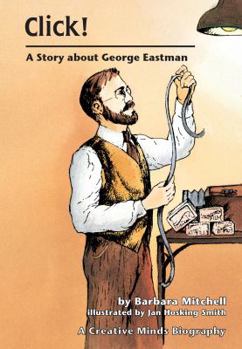Click!: A Story about George Eastman
Select Format
Select Condition 
Book Overview
Follows the life and career of the man who revolutionized photography by developing a camera simple enough for anyone to use. This description may be from another edition of this product.
Format:Paperback
Language:English
ISBN:0876144725
ISBN13:9780876144725
Release Date:August 1986
Publisher:Lerner Classroom
Length:56 Pages
Weight:0.28 lbs.
Dimensions:0.2" x 5.8" x 8.5"
Age Range:9 to 14 years
Grade Range:Grades 4 to 9
Customer Reviews
1 rating
The Man Who Brought Photography To The General Public
Published by Thriftbooks.com User , 15 years ago
This 56-page book is obviously a children's book. Considering that George Eastman, the man who figured out how to bring the delights of taking photographs to everybody, was a bit of a boring story, the book does a decent job of making his story interesting to children. Kodak is one of the most famous brand names in the world. The originator of that name was a man who worked in a bank to support his widowed Mother. After failing to master playing the flute as a hobby, he took up photography. Doing photography at that time meant carting around 50 pounds of equipment including chemicals, glass plates that became the negatives, and a portable darkroom for quickly processing the pictures immediately after the photograph was taken and before the exposed chemically treated wet glass plates dried. Eastman heard that the English had developed a process for making a dry coating for the glass negative plates. Eastman basically invented a similar gelatin process for making dry plates. It was very successful and made photography much easier. He then decided that rather than individual glass plates it would be easier if the individual negatives could be put onto a roll. Later, he combined his rolls of dry coated film into a camera that could be bought inexpensively and once the pictures were taken, the entire camera was sent to Kodak for processing. The finished prints, negatives and a new fully loaded camera was sent back to the photographer. Eastman eventually made the process even simpler and quicker by making rolls of film that the photographer could reload into his camera so only the exposed roll needed to be sent to Kodak for processing and printing. Eastman believed in mass production via assembly lines and soon his Brownie camera was available at a price that even children interested in taking photos could afford. The development of these chemical and industrial processes isn't exactly an exciting story to most children so the author also points out how George Eastman donated much of his fortune to good causes including MIT and Tuskegee, a school for black students that was struggling to survive. The author does a pretty good job making the biography interesting to children by including some of Eastman's hunting and fishing expeditions along with his interest in personally cooking for his expedition guests. Thomas Edison used Eastman's camera and film to develop motion pictures. All in all, this is about as interesting an introduction to one of the important pioneers of photography that I've seen that will be able to capture the attention of a younger audience. Everyone has heard of Kodak, but few know the remarkable story behind the name or the importance of it to photography in all its forms.





